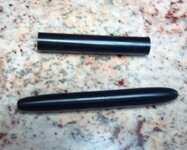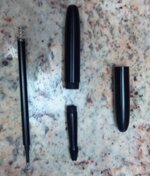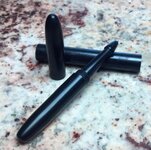TerryDowning
Member
I get 5/8" and 1/2" Urethane rods from work (cast offs as these are gates from large castings.)
Right now I have mostly black. Usually the rods are solid colors. Here is what I have done with some of it.
On top is some left over rod to show what I start with.
The pen is on the bottom.

This is a really simple design. I am using this as a prototype for different ideas. Closed both ends, section threads (3/8" x 24) into body, clipless cap threads (1/2" x 20) onto body. And of course the refill and spring.

All done.

If you thought finishing CA over wood or swirly acrylic was tough, try finishing solid materials. There is absolutely nothing to hide the swirls and scratches. I don't have any Micromesh, but I can see I need to invest in some. Wet sanded to 2000, ScratchX2, and some carnuba wax to bring up the shine.
Let me know what you think.
Terry
Right now I have mostly black. Usually the rods are solid colors. Here is what I have done with some of it.
On top is some left over rod to show what I start with.
The pen is on the bottom.

This is a really simple design. I am using this as a prototype for different ideas. Closed both ends, section threads (3/8" x 24) into body, clipless cap threads (1/2" x 20) onto body. And of course the refill and spring.

All done.

If you thought finishing CA over wood or swirly acrylic was tough, try finishing solid materials. There is absolutely nothing to hide the swirls and scratches. I don't have any Micromesh, but I can see I need to invest in some. Wet sanded to 2000, ScratchX2, and some carnuba wax to bring up the shine.
Let me know what you think.
Terry
